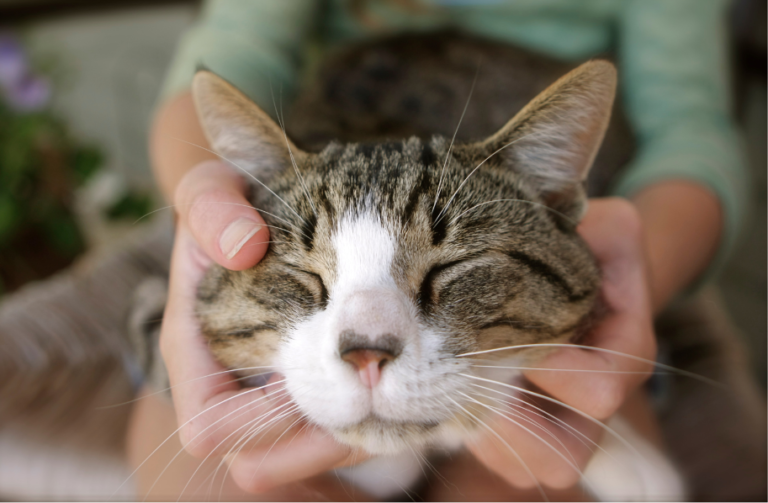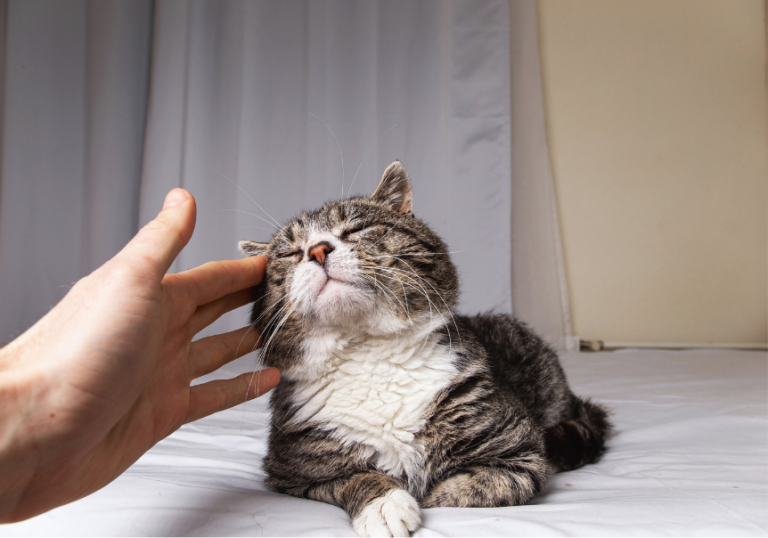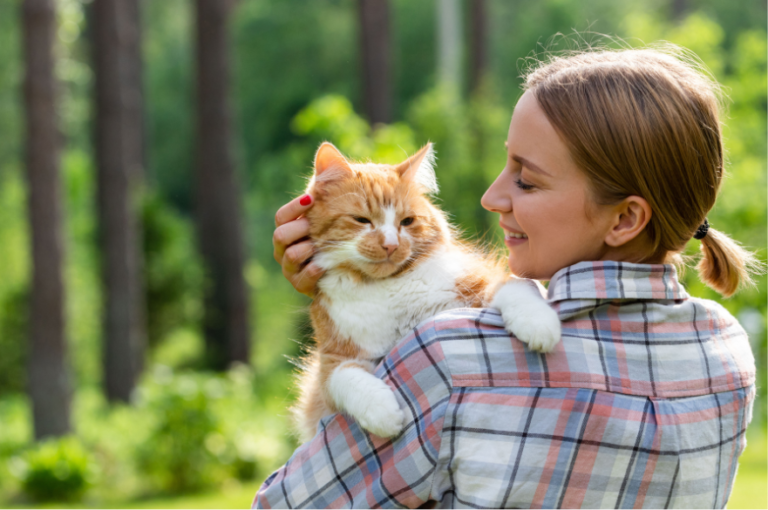How to Tell if Your Cat is Happy and Loving Life?
Discover the subtle clues that reveal your cat’s happiness.
Contents
Toggle
Cats are often seen as mysterious and self-reliant animals, which can make it challenging to accurately assess their emotional well-being. Cats don’t have the same obvious signs of happiness as dogs, like wagging tails or broad smiles, which can make it more challenging to understand when they’re truly content. Cats haven’t evolved to be as socially expressive as some other animals, so they communicate through more subtle signals such as body posture, facial expressions, and scent—methods that can be puzzling for us humans. However, as a devoted cat parent, it’s natural to want your feline friend to feel emotionally fulfilled as well as physically healthy
Thankfully, cats have their own unique ways of communicating their feelings, and by paying close attention to their body language, you can get a good sense of their happiness. Taking the time to observe and understand their behavior ensures they feel loved, secure, and comfortable—and shows how much they value their relationship with you.
Why Understanding Your Cat’s Happiness Matters
Understanding your cat’s happiness goes beyond just noticing their mood, it’s directly linked to their overall health and well-being. A happy cat is more than just a playful companion—they are more physically active, emotionally balanced, and better able to cope with stress or changes in their environment. On the flip side, recognizing when your cat is unhappy can help you detect early warning signs of stress, illness, or discomfort.
Cats are experts at masking their pain or discomfort, so understanding their body language, behavior, and subtle cues becomes your first line of defense. If they seem off or show changes in their usual habits—like suddenly becoming withdrawn, eating less, or grooming less frequently. Those are red flags that shouldn’t be ignored. By understanding the connection between happiness and health, you can ensure your furry friend enjoys a well-balanced life, emotionally and physically.

Signs Your Cat Is Happy
Purring: The Happy Vibe
Purring is like a cat’s unique melody, often the first clue that they’re happy. This gentle, rhythmic vibration usually signals that your feline is relaxed and content, enjoying their surroundings or the company they’re in. When your cat curls up in your lap, kneads their paws and lets out a soft purr, it’s their way of saying, “I feel safe and happy with you.”
However, it’s important to note that not every purr signals happiness. Cats can also purr in moments of stress, fear, or discomfort as a way to calm themselves or seek reassurance. For instance, a cat might purr while healing from an injury or during a visit to the vet. This is why understanding the situation is essential to accurately interpret what your cat is communicating.
Observe your cat’s body language and surroundings alongside the purring. A relaxed body, half-closed eyes, and a slow, rhythmic purr likely indicate joy. In contrast, purring combined with flattened ears, dilated pupils, or crouched posture might suggest discomfort or anxiety.
Relaxed Body Language
One of the clearest signs of a happy cat is their relaxed and comfortable posture. Cats are naturally cautious creatures, so when they allow themselves to truly unwind, it’s a strong sign that they feel safe in their environment.
Stretching Out: When a cat stretches its body out fully, it’s not just about flexibility, it’s a clear indicator of security. Stretching often happens when they’re lounging in their favorite spot, showing that they feel completely at ease and unthreatened.
Exposed Belly: If your cat rolls onto their back and shows you their belly, consider it the ultimate sign of trust. The belly is one of the most vulnerable parts of a cat’s body, so exposing it signals they feel secure enough to let their guard down.
Tail Talk
Tail movements are one of the most expressive ways cats communicate their emotions. A happy cat often holds its tail high, signaling confidence and contentment. The tail may even have a slight curl at the tip, which is a sign of curiosity or a gentle mood. When lying down, a cat that’s feeling relaxed and content might gently wag their tail in small, slow motions, similar to a subtle wag in dogs. This isn’t a sign of agitation, but more of a calm response to a pleasant environment. A wagging tail in this context often indicates a deep level of comfort and happiness, showing your cat is relaxed and enjoying their surroundings.
Slow Blinking: The Cat Kiss
When your cat gazes at you and slowly blinks, they’re sharing an intimate moment with you, almost like saying, “I trust you completely.” Cats usually avoid making prolonged eye contact with strangers. So, by closing their eyes gently and reopening them, they’re offering you a non-verbal token of affection.
This behavior is often referred to as “cat kisses” because it mimics the act of kissing, but in a more delicate, feline way. By blinking slowly back at your cat, you’re strengthening the bond between you. Cats enjoy building strong emotional connections with their humans, and slow blinking is one of the most heartwarming ways to reciprocate their love.
Good Appetite
Just like us, cats’ appetites can fluctuate based on factors like stress, illness, or environmental changes. So, when your cat eagerly digs into their meals and snacks, it suggests they’re in a positive state of mind. Cats, by nature, are somewhat particular about their food, so when a cat feels secure and stress-free, they’re more likely to approach their food with interest and anticipation, even showing excitement when they hear the sound of their food bowl being filled or the rustle of a treat bag.
However, a loss of interest in food or a sudden change in eating habits can indicate something’s wrong, such as stress or illness. If this occurs, you should pay attention to other signs—like unusual behavior or a change in litter box habits.
Healthy Grooming Habits
A clean, shiny coat is not just a sign of good hygiene but also an indication of emotional well-being. Cats that groom themselves regularly are feeling secure in their environment, as grooming is a self-soothing activity that helps them relax.
But grooming isn’t just about taking care of themselves. Cats that groom you or other pets in the household are also showing signs of affection and trust. This behavior, known as allogrooming, is a social act that bonds cats to their companions. When your cat licks your hand, brushes against your leg, or gently nibbles on another pet’s fur, they are reinforcing the connection between you and expressing love and comfort.
If your cat suddenly stops grooming or starts obsessively licking or nibbling one specific area, it may signal stress, anxiety, or even pain. Cats are naturally meticulous about their grooming, so any changes in their usual routine warrant close attention.
If your cat suddenly stops grooming or starts obsessively licking or nibbling one specific area, it may signal stress, anxiety, or even pain. Cats are naturally meticulous about their grooming, so any changes in their usual routine warrant close attention.
Playfulness and Energy
Playfulness is a clear and joyful expression of a happy cat. Happy cats exhibit curiosity and energy, showing interest in their surroundings and eagerly interacting with their environment.
For kittens and younger cats, play is a way to burn off their endless energy and satisfy their natural hunting instincts. You’ll see them leaping, pouncing, and stalking their favorite toys with pure excitement. Adult cats, while often a bit calmer, still love to play when they feel happy and safe. Whether it’s batting at a feather wand or chasing a laser pointer, these playful moments are a clear sign that your cat is content.
If your cat seems less interested in activities they once enjoyed,it may be time to consider possible health concerns or changes in their environment that could be affecting their mood.
Seeking Affection
Cats may not always be as openly affectionate as dogs, but when they seek interaction, it’s a strong indicator of trust and contentment.
A content cat may gently nuzzle your hand with their head, a behavior called “head bunting.” This is their way of marking you with their scent, signifying that you’re a trusted part of their territory and their safe environment. They may also rub against your legs when you walk in the door, a feline way of greeting and bonding. If your cat hops onto your lap, kneads with their paws, or curls up beside you for a nap, they’re expressing their comfort and attachment.
Some cats express affection by following you from room to room or “talking” with soft meows or chirps. While every cat has a unique way of showing love, these behaviors indicate a happy, secure feline who enjoys your company.
It’s important to remember that not all cats show affection in the same way. Some cats might prefer sitting close to you rather than cuddling up directly on your lap. Understanding your cat’s individual personality and respecting their boundaries helps build a stronger bond and ensures they’ll keep coming to you for comfort and companionship.
How to Keep Your Cat or Kitten Happy
Whether you have a playful kitten or a calm adult cat, these furry companions are creatures of routine who need attention, affection, and care to stay content. By recognizing and responding to your cat’s specific needs and behaviors, you can ensure they remain healthy and emotionally fulfilled.
Provide a Stimulating Environment
Cats are naturally curious creatures, so it’s essential to create an environment that offers plenty of stimulation. Keeping them entertained with toys, scratching posts, and cozy places to hide or perch can prevent boredom and reduce stress.
Maintain a Healthy Diet
Just like any pet, your cat’s happiness depends significantly on their nutrition. Providing a balanced diet suited to their age, health, and preferences is essential for their overall well-being.
- Choose High-Quality Food: Select food that is specifically formulated for your cat’s life stage. Kittens need food packed with protein and fats to support their growth, while adult and senior cats have different dietary needs. Consult with your veterinarian to determine the best food for your cat’s breed and health condition.
- Hydration is Key: Cats are notorious for not drinking enough water, which can lead to urinary tract issues. Consider providing a cat water fountain to encourage hydration, as many cats prefer moving water. Additionally, wet food can supplement your cat’s water intake.
Create Safe Spaces
Cats love to have places they can call their own, where they can retreat to when they feel the need to relax or escape from too much activity. Offering them various safe spaces in your home will help reduce anxiety and make them feel secure.
- Hideaways and Perches: Cats enjoy hiding in quiet, enclosed spaces or lounging in elevated areas where they can observe their surroundings. A cozy cat bed, a small hideaway, or even a high perch in the form of a window seat or shelf can give them a sense of security.
Maintain a Routine
Maintaining a consistent routine for feeding, playtime, and grooming can help alleviate stress and promote happiness.
Consistent Feeding Times: Cats thrive on routine, so try to feed them at the same times every day. This helps them feel secure and establishes a predictable pattern for their day.
Litter Box Maintenance: Keep your cat’s litter box clean and place it in a quiet, easily accessible location. Cats can be particular about their bathroom habits, and a clean box can help them feel comfortable and content in their space.
Schedule Regular Vet Visits
Routine checkups with a veterinarian are essential to ensure your cat remains healthy. Preventive care, including vaccinations, flea control, and parasite treatments, will help your cat avoid illness and stay happy in the long run.
- Monitor for Health Changes: Regular vet visits allow you to catch any potential health issues early. Cats can be quite stoic when they’re feeling unwell, so regular checkups and attention to subtle signs of distress are crucial to keeping them happy and healthy.
- Dental Care: Oral health is often overlooked in cats, but it’s a key aspect of their overall well-being. Regular dental checkups, combined with at-home brushing or dental treats, will help prevent dental disease, which can lead to discomfort and other health problems.
Keep Their Environment Calm and Stress-Free
Stress can affect your cat’s happiness, so creating a calm, quiet environment is essential. Avoid loud noises, sudden changes, or anything that could disrupt your cat’s sense of security. To minimize stress, create a quiet space where your cat can retreat to when they need some downtime. By minimizing stressors and providing a safe, secure space, you contribute to your cat’s happiness and overall emotional health.
